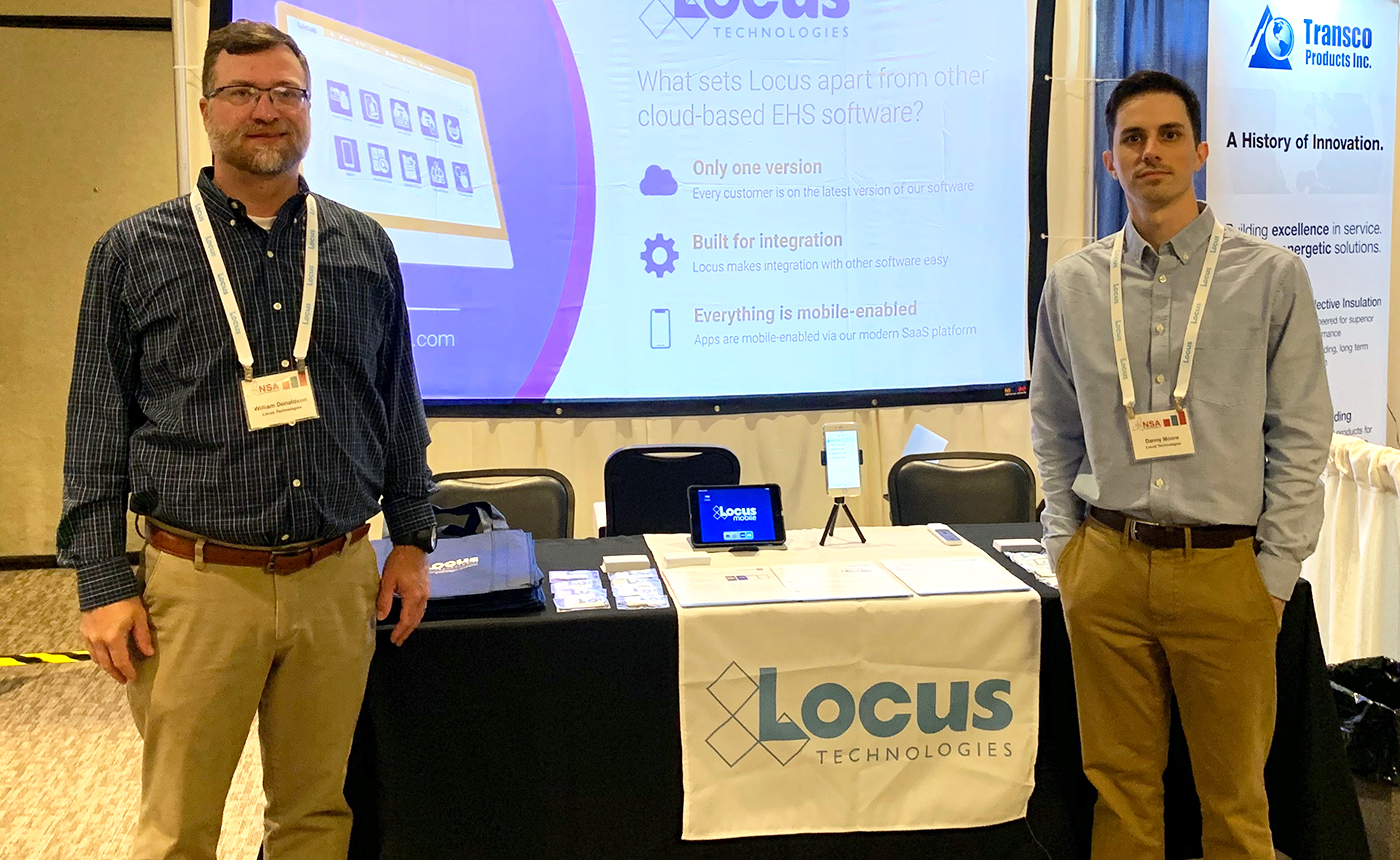Reviving the Nuclear Industry: How Locus’ Software is Leading the Way
At Locus, we are proud to play a pivotal role in this revival, building on our decades of expertise and deep roots in the nuclear sector.
At Locus, we are proud to play a pivotal role in this revival, building on our decades of expertise and deep roots in the nuclear sector.
Locus recently joined the nuclear power plant community in Orlando, FL for this year’s Radiological Effluents and Environmental Workshop. It’s always a pleasure to join other professionals in a space that encourages discussion, education, and awareness of industry processes and compliance.

Bill Donaldson and Danny Moore of Locus Technologies.
Each conference we attend is an opportunity to learn. Whether talking with current or potential customers, it’s always fascinating to hear some of the success and horror stories experienced in their daily operations. We’ve summarized a few of those conversations below. And since REEW takes place in the summer, there’s a theme.
 Version Island
Version IslandImagine you’ve spent years utilizing a certain feature of your radiological software. You’ve gone through the training process, the growing pains, and you are finally enjoying the fruits of that labor. Now imagine learning that the latest and greatest version being released has removed the feature that you’ve grown to rely on. You are now stuck on a version island. At this point, a costly and time consuming upgrade will cause more problems. Locus SaaS has no version numbers, meaning you will never need to upgrade.
 Off the Grid
Off the GridAt one time, the simple columns and rows in Excel seemed to provide a sufficient solution to prepare your REMP sampling data for reports. However, when you need to transfer data between systems, or create more sophisticated reports, those grids begin to feel like prison bars. Maybe it’s time to go off the grid and deploy a more modern solution that can connect and work side by side with your existing tools.
 Sunsetting (Decommissioning)
Sunsetting (Decommissioning)Closing a power plant is a long and involved process that many attendees were in the process of dealing with or will be in the near future. This operational change can be the motivation to rethink the way radiological data is sampled and managed. Some software packages can be too big for the job. Locus offers a modular approach where you only pay for what you need. Choosing which system tools are relevant to the type of data sampling and resources available can minimize implementation cost and increase productivity.
 Serene Security
Serene SecurityMany people we spoke with at REEW had serious security concerns. Locus takes those concerns seriously. We are SOC 1 and SOC 2 certified and have migrated our software to Amazon Web Services. All customer data is stored with AWS, one of the most advanced and secure cloud-hosting providers on the planet. Locus provides the ability to control user permissions, customizing access based on job duties. This provides a more granular approach to data security.
 Making Plans
Making PlansUsing a sample planning application organizes sample events and allows for scheduling weeks, months, or years in advance. Many were interested in this powerful tool that is flexible enough to adapt when a reactor changes modes, allowing for one-time, ad-hoc samples. Mobile applications that integrate with planned samples and events minimize setup, ease data collection, speed up loading field data, and can expedite samples to the lab more efficiently.
Your feedback has helped Locus build a solution that makes it easy to manage all your facility’s data for RETS/REMP, helping you meet your NRC reporting requirements. We enjoyed speaking with everyone at REEW and we look forward to seeing you again next year!
Learn more about Locus for Nuclear.
About the author—Danny Moore, Locus Technologies

Mr. Moore has spent the last decade designing and marketing for enterprise SaaS systems. In his career at Locus, he leads a team of marketing professionals in branding, content creation, social media engagement, and email outreach. Mr. Moore enjoys attending conferences as a Locus brand ambassador and sharing any feedback gained to improve product development.
About the author—Bill Donaldson, Locus Technologies

Mr. Donaldson has 5 years experience in SaaS systems, performing Product Management and QA/QC of Locus Mobile iOS application and Locus’ Environmental Information Management system (EIM). While completing his B.S., Mr. Donaldson held several paid internships, where he configured a Relational GeoDatabase and a Database Management System (DBMS), for biological data entry.
Plans to build the UK’s first new nuclear plant in decades, Hinkley Point in Somerset, received an unexpected setback when the government said it wanted to delay its final decision on the project.
The proposed plant is known as Hinkley Point C and would be built next to two existing facilities, Hinkley Point A and B. For the UK it would deliver 7 percent of UK’s electricity when most other nuclear power stations have closed down. At £24bn, it is the biggest and riskiest energy infrastructure project in British history and the decision as to whether it goes ahead lies with the new government that postponed the decision to September. The new UK government will “consider carefully” before proceeding with the project.
French firm EDF, which is financing most of the Hinkley Point project, approved the funding at a board meeting last week. Some in the new government are also concerned that the plant is being built by foreign governments. One-third of the total cost is being provided by Chinese investors. These funding arrangements mean the cost will not end up on the government’s books.
The low-carbon electricity will help towards EU and British climate change goals. The huge project, the largest in Europe, would provide an economic stimulus.
Ever since the UK government committed the nuclear energy in 2006, successive governments have argued that nuclear power is necessary as part of UK’s generation mix and to meet the UK’s climate change commitments.
Nuclear also delivers base load electricity – that is, the amount of power that is needed to satisfy minimum demand – because it is always available. That’s important as more intermittent renewables – such as the wind and solar power – come on to the grid.
According to recent calculations by Bloomberg News, Tokyo Electric Power Co. (Tepco) is unlikely to meet its March 2015 deadline to complete the filtering of cancer-causing radioactive isotopes at its wrecked nuclear plant in Fukushima.
Tepco’s President, Naomi Hirose, made a commitment to Prime Minister Shinzo Abe in September of last year to remedy the contamination of groundwater their plant has caused. Bloomberg estimates suggested that filtering out the isotope strontium, which has been linked to leukemia, from the stored water will take more time than they have left with the set deadline.
Spokeswoman Mayumi Yoshida stated earlier this month that Tepco can, “only say we’ll make efforts to achieve that target” of reaching their goal of decontamination before the deadlines that are less than a year away.
The prolonging of the cleanup process has other implications as well, including an extension on a South Korean ban on Japanese seafood imports, and an increased demand in the U.S. for an international takeover of the cleanup process. While the implications of not completing the cleanup on time have not yet been discussed, Tepco is continually seeking ways to remedy the after effects of the March 11, 2011 accident.
The levels of toxic waters are continually rising at a rate of 400,000 liters per day, and as of July 29, the site was said to have more than 373,000,000 liters of radioactive water still needing treatment. With numerous failed attempts at reducing the amount of irradiated water released, Tepco’s ability to reach the deadline is looking incredibly bleak, but Yoshida reassures, “we are doing everything we can do.”
Years later we are once again being reminded of the Fukushima crisis and the magnitude of its effects. Just as it was discussed in the aftermath of the incident, the assistance of a cloud-based, centralized data management system could help to take action on the cleanup. With today’s technology it is possible to store relevant data in a system that is accessible to all stakeholders, supplies a way to continuously monitor and analyze levels of isotopes, and offers opportunities to make better decisions and improve safety at nuclear power plants.
One of the chief complaints of Japanese citizens—and indeed the world community—as the crisis at the Fukushima Daiichi plant has unfolded has been the lack of information that TEPCO, the electric utility that owns and operates the plant, (and the Japanese government) have shared. From thousands of miles away, the nuclear community is piecing together forensic analysis [see NYTimes article from April 3, “Japan’s Nuclear Crisis Is Seen Clearly From Afar”] in an attempt to understand the severity of the crisis. As the world braces for the worst-case scenario, the models that these scientists are running are based only on data approximations. It does not need to be that way.
Fukushima is not just Japan’s problem—we’re all going to be dealing with the fallout from this situation for years. The data collection process and the sheer quantity make managing the data a challenge. Having on-site data storage is risky. If the plant blows up and you lose any critical data; using Cloud technology will allow not only aggregation for the sake of TEPCO, but also for the world community. We all need to be able to see and learn from the data to help Japan solve the problem. It’s bigger than they are—especially when it comes to ocean/fish contamination. TEPCO should learn from the BP oil spill and make data immediately transparent. On the anniversary of BP Gulf Oil Spill public still does not have access to the extent and magnitude of contamination caused by that disaster.
Centralized and reusable data now and in the future will help us all make decisions and take action on the cleanup—and improve safety and fail safes at the rest of the planet’s nuclear power plants. The partial meltdown of three reactors and at least two spent fuel pools, along with multiple hydrogen explosions at the site now rate a 7 on the International Nuclear Event Scale—a level previously pinned only to the meltdown and explosion at the single reactor at Chernobyl. After the immediate crisis at the Fukushima is bought under control, attention will shift to characterizing the impact of the disaster on human health and the environment and on long-term monitoring and stewardship. At this point, an opportunity exists for TEPCO, to get out in front of the crisis and become as transparent as possible about the evolving conditions at the plant and surrounding areas. To do so, it should move all information gathered on the nature and extent of the releases at the facility to the “Cloud”. Soviet and Russian authorities never did this on Chernobyl, and the general public still does not know the exact extent of that disaster to the human health and environment. The amount of data that is likely to be collected by TEPCO and others in the coming years will be a tsunami in its own right and may be as challenging to deal with as the real one unless the proper information management system is put in place. Samples of air, soil, groundwater, and seawater, as well as various biota, including crops and fish, will be collected from all potentially impacted areas. These will be measured for various radionuclides, all of which have various half-lives. The resulting information will need to be evaluated for both short and long-term impacts on humans and the environment. This can best be accomplished if all relevant data is stored in a centralized information management system that is accessible to all stakeholders. The web makes all this not only possible but quite doable. Many US nuclear utilities and US DOE nuclear weapons sites are already managing their operational data in the Cloud and are well aware of the importance of information management technologies that Cloud offers.
Deploying a centralized environmental management system to the Cloud, and placing all data in it, would allow all interested parties to know where samples of various media have been taken, what parties collected them, how the samples were analyzed, what the levels of radionuclides were in these samples, and what the legal limits and long-term effects of each isotope are. The general public is unlikely to have the sophistication to deal with most of this data. Rather, valid conclusions as to the impacts of the contamination are only likely to be drawn by those experienced in statistics, modeling, risk assessment, and/or health physics.
For More information please see: Japan quake data should be stored in the cloud
MOUNTAIN VIEW, Calif., 2 March 2023 — Locus Technologies, the leading EHS Compliance and ESG software provider, received their 17th consecutive award from Environmental Business Journal (EBJ) for growth and innovation in the field of Information Technology in the environmental software with particular focus on EHS, compliance, sustainability, and ESG.
Locus continues to expand its ESG SaaS solution, including built-in business intelligence tools for interactive, actionable insights into unified EHS compliance and ESG data, forecasting tools predicting future ESG reporting, APIs for utility data sources, and interfaces with third-party systems that house ESG data. Locus’s ESG solutions focus on “enter once, report to many.” enabling companies the efficiency of reporting to multiple organizations and numerous standards from a single dataset. Essential built-in reporting includes state or federal regulations and ESG based on standards, including CDP, GRI, SASB, TCFD, and many others.
“Locus’s pioneering work in integrated ESG reporting and EHS compliance software is paying off. As one of the early SaaS leaders in net-zero digital solutions for ESG reporting, Locus continues to provide value to companies that want to be credible with their carbon reporting and sustainability software.” said Grant Ferrier, president of Environmental Business International Inc. (EBI), publisher of Environmental Business Journal.
“With energy transition, climate resilience, and new federal programs driving business, as well as traditional environmental market drivers in infrastructure, air quality, remediation, water and wastewater it is understandable that companies that offer integrates SaaS platform like Locus has advantage.” added Ferrier.
“As Locus continues to expand our EHS and ESG software we would like to thank EBJ for recognizing Locus again for a 17th consecutive year and for noting the new functionality and growing customer base we achieved in 2022. Locus will continue this trajectory into 2023 with new tools designed to simplify EHS and ESG management in our award-winning Locus software, which offers a single system of record and truth for our customers. Locus SaaS platform enables our customers to manage their carbon transactions and inventory with the same rigor, confidence, and transparency as their financial ones.” said Neno Duplan, the Founder and CEO of Locus Technologies.
MOUNTAIN VIEW, Calif., 24 February 2022 — Locus Technologies, the leading EHS Compliance and ESG software provider, was awarded a 16th consecutive award from Environmental Business Journal (EBJ) for growth and innovation in the field of Information Technology in the environmental software with particular focus on ESG.
EBJ is a business research publication providing strategic business intelligence to the environmental industry. Locus received the 2021 EBJ Award for Information Technology by growing and innovating its unified EHS compliance and ESG software platform.
In 2021 Locus took a leading market position in the fast-growing space of ESG software. Locus’s ESG SaaS covers carbon data aggregation via a powerful visual calculation engine, investor-grade emissions calculations audit capabilities, reporting to multiple standards from a single data set, integration APIs, dashboards, and carbon reduction goal setting and tracking. This separates Locus from competitors as customers demand integrated net-zero ESG software that supports investor-grade data in disclosure rules such as the EU’s corporate sustainability reporting directive, mandatory TCFD reporting, and anticipated SEC action on climate disclosures.
In 2021 Locus continued to expand its ESG SaaS to include built-in business intelligence tools allowing for interactive, actionable insights into EHS and ESG data, forecasting tools to predict future ESG reporting, APIs linking to utility meters, and interfaces with other Locus and third-party systems that house ESG data. Locus’s ESG application is focused on “enter once, report many times.” The gold standard for multinational enterprises with many locations worldwide is to have a system configured to report to multiple organizations and many standards from a single dataset. Essential built-in reporting in the Locus ESG app includes state or federal regulations, internal CSR, and ESG based on whatever standard their organization adheres to, such as CDP, GRI, SASB, TCDF, or more recent World Economic Forum (WEF) attempt to standardize many voluntary standards.
Locus also expanded its ESG consulting expertise by becoming the first and only software provider to offer accreditation services under new Oregon DEQ guidelines requiring third-party verification for GHG and CFP programs.
Besides strong growth in ESG space, Locus also continues to lead the software for water quality management market with the addition of new SaaS customers in 2021, such as the City of Hillsboro, Oregon for water quality management and Westinghouse Electric Company for control of environmental and radionuclides data, cementing Locus’s market leader position in the space of nuclear facilities.
“Locus’s investment in integrated carbon management software and EHS compliance is paying off. As one of the early SaaS leaders in net-zero digital solutions for ESG reporting, Locus continues to provide value to companies that want to be credible with their carbon reporting and sustainability software.,” said Grant Ferrier, president of Environmental Business International Inc. (EBI), publisher of Environmental Business Journal.
“We would like to thank EBJ for recognizing Locus for a 16th consecutive year and for taking note of our industry-leading ESG software. We aim to continue expanding our software offerings to customers in 2022,” said Wes Hawthorne, President of Locus Technologies.
299 Fairchild Drive
Mountain View, CA 94043
P: +1 (650) 960-1640
F: +1 (415) 360-5889
Locus Technologies provides cloud-based environmental software and mobile solutions for EHS, sustainability management, GHG reporting, water quality management, risk management, and analytical, geologic, and ecologic environmental data management.
